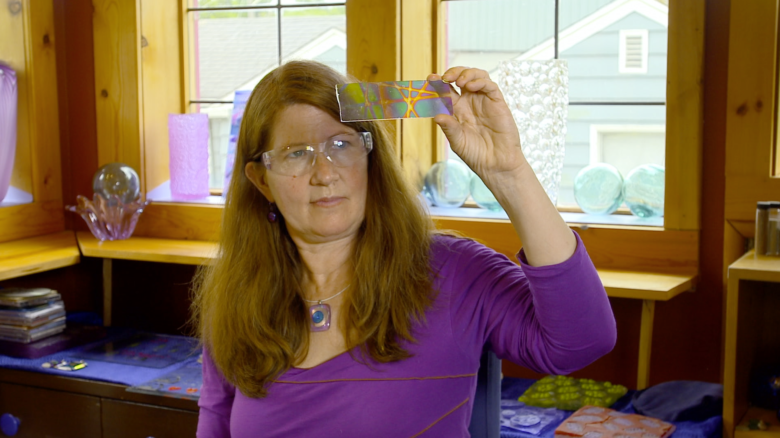Marcia Wiley, Glassware

Marcia Wiley
Based in Seattle, Marcia Wiley believes every day can be lived with style and simple abundance. Each of her colorful drinking glasses is made one at a time, using classic glassblowing tools and techniques. You can also view her explain how to Drink in Brilliance Every Day.
Have you always worked with your hands?
Yes, very much so. I learned to knit and sew as a little girl and made my own clothing from elementary school on. I love to draw and doodled my way through my high school, college, and graduate school classes.
What drew you to your chosen craft?
As a child I found my grandparents’ handmade marbles. I loved their visual surprises; the whole worlds contained within, and the combinations of color and shadow that popped up with changing light. Overnight, I was irresistibly drawn to glassiness: shiny bits of gravel on the sidewalk, garnets culled from beach sand, window prisms that cast brilliant colored beams, and reflections of icicles in the Berkshire Mountains where I grew up.
I was drawn to the interactions between color and light. I loved sunsets as a child (and still do) and have memories of begging my parents to take me to the best place to watch them. One of my favorite annual rituals was seeing the sunrise over the Chesapeake Bay Bridge on family road trips.
As an undergraduate I majored in Geology-Biology. I was intrigued by how molten rock forms crystalline structures at the earth’s surface, and by the treasures of fossil rock. The glassblowing class I took at the Rhode Island School of Design inspired me to learn more about and work with molten material. The many years of travel I subsequently undertook—living in India and Central America for five years—opened my eyes further to the incredible array of pattern and form in the natural world and the ways in which different peoples use glass as a functional and decorative material. In Seattle, the ever changing light and reflection on the water and mountains is a daily source of inspiration for mixing color and light within my glassware.
I’m a nature lover and with glass it is possible to recreate and imitate the things I love most about nature.
What do you enjoy most about your craft?
So many things! The surprise of never quite knowing how something will turn out when you open up the kiln. The unpredictability and mystery of glass as a material-the unlikelihood of its existence and the many magical ways it plays with light and color.
Seattle is considered to be the glass capitol of the world and it is a joy to live in a community of learners with so much expertise. There are so many ways of working with glass and due to recent standardization in glass materials, it is now possible to combine glass made using different techniques. It’s an exciting time to be a glass artist and I’m in the best place to be one!
I am also particularly interested in glass types that color shift and the technology behind these types of glasses (dichroic, reactive) is relatively recent.
How long did it take you to become an expert?
Honestly, I’m no expert. I am always learning and trying out new things. But I have a very curious and creative mind……
Do you feel like you are still learning?
Constantly. Glass is a deeply rich medium offering lifetimes of study.
 How many hours do you spend making each item?
How many hours do you spend making each item?
Anywhere between 30 minutes (earrings) and 6 to 8 weeks (kiln cast bowls). The drinking glasses take about thirty minutes to make from A to Z.
If you could spend a day with a master of your craft (past or present), who would it be and why?
Ann Robinson, a New Zealand artist. I love her clean designs that show off the simple beauty of glass and her use of intense color.
Christopher Ries, a US sculptor who polishes and cuts glass perfectly to create amazing optic effects.
Is there any one person who has bought/used any of your products that makes you especially proud?
- Chris Squire (rock musician, founder of the band YES)
- Martha Beck, life coach guru
- Elizabeth Kolbert, sustainability author
- Bruce Lipton, brain function author
- Tim Allen, actor
The variety of these people shows the wide appeal of my simple and elegant glassware.
What does the future hold for your type of work? Are you training young people in your craft?
Hand blown glass is more expensive than machine made glass and consumers often value price over craftsmanship (and have gotten used to a flood of decent enough looking glass being made in China and Mexico). Worldwide, some of the most longstanding historic glass companies have closed in recent years (studios in Eastern Europe and in Murano Italy). Traditional knowledge is being lost as new advances in technology and new artistic minds are pushing the field of glass art in new directions. The field is moving from traditional artisanal crafts to sculptural forms.
Why is it important for people to make things with their own hands?
This is a deeply human need. We are a species of makers, each of us in our own way.
In what ways are handmade goods better than those that are mass-produced?
They are individual objects, made one at a time, bearing the marks of the people who made them. They carry the energetic imprint of their maker which establishes a connection with the user.
And-typically, they are more beautiful! There’s no comparison.
When you buy something that is handmade you are getting a piece of the artist. Artists tend to be super creative intelligent people-who doesn’t want more of that in their lives?
—
With gratitude…



